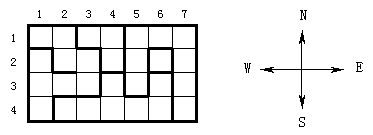POJ-1164 The Castle(稍加思考的DFS泛洪)¶
Description¶
这里还是借用一本通-1250:The Castle的题目描述,更清晰一些。
一座城堡被分成m*n个方块(m≤50,n≤50),每个方块可有0~4堵墙(0表示无墙)。下面示出了建筑平面图:

图中的加粗黑线代表墙。几个连通的方块组成房间,房间与房间之间一定是用黑线(墙)隔开的。
现在要求你编一个程序,解决以下2个问题:
1、该城堡中有多少个房间?
2、最大的房间有多大?
Input¶
Your program is to read from standard input. The first line contains the number of modules in the north-south direction and the number of modules in the east-west direction. In the following lines each module is described by a number (0 <= p <= 15). This number is the sum of: 1 (= wall to the west), 2 (= wall to the north), 4 (= wall to the east), 8 (= wall to the south). Inner walls are defined twice; a wall to the south in module 1,1 is also indicated as a wall to the north in module 2,1. The castle always has at least two rooms.
平面图用一个数字表示一个方块(第1个房间用二进制1011表示,0表示无东墙,用十进制11表示)。
第一行一个整数m(m≤50),表示房子南北方向的长度。
第二行一个整数n(n≤50),表示房子东西方向的长度。
后面的m行,每行有n个整数,每个整数都表示平面图对应位置的方块的特征。每个方块中墙的特征由数字P来描述(0≤P≤15)。数字P是下面的可能取的数字之和:
1(西墙 west)
2(北墙 north)
4(东墙 east)
8(南墙 south)
室内的墙被定义两次: 例如方块(1,1)中的南墙也被位于其南面的方块(2,1)定义了一次。
建筑中至少有两个房间。
Output¶
Your program is to write to standard output: First the number of rooms, then the area of the largest room (counted in modules).
Sample Input¶
4
7
11 6 11 6 3 10 6
7 9 6 13 5 15 5
1 10 12 7 13 7 5
13 11 10 8 10 12 13
Sample Output¶
5
9
这道题目最重要的是理解题意。对于墙的描述采取二进制的方法,所以在东南西北四个方向移动之前,需要先用位运算检验一下对应的位是否为0,然后才可以移动,剩下的问题就变成了Lake Counting的泛洪算法了。
#include <iostream>
#include <iomanip>
#include <string>
#include <vector>
#include <queue>
#include <list>
#include <map>
#include <set>
#include <algorithm>
#include <cmath>
#include <climits>
using namespace std;
int m, n;
vector<vector<int> > grid(55, vector<int>(55));
vector<vector<bool> > used(55, vector<bool>(55));
int maxVal = 0, tmp;
int direction[4][2] = {{1, 0}, {-1, 0}, {0, 1}, {0, -1}};
int checkSign[4] = {8, 2, 4, 1};
void DFS(int row, int col)
{
maxVal = max(maxVal, tmp);
for (int i = 0; i < 4; ++i) {
if ((grid[row][col] & checkSign[i]) == 0) {
int nextRow = row + direction[i][0];
int nextCol = col + direction[i][1];
if (0 <= nextRow && nextRow < m && 0 <= nextCol && nextCol < n && !used[nextRow][nextCol] > 0) {
used[nextRow][nextCol] = true;
++tmp;
DFS(nextRow, nextCol);
}
}
}
}
int main()
{
std::ios_base::sync_with_stdio(false);
cin.tie(NULL);
cout.tie(NULL);
cin >> m >> n;
for (int i = 0; i < m; ++i) {
for (int j = 0; j < n; ++j) {
cin >> grid[i][j];
}
}
int cnt = 0;
for (int i = 0; i < m; ++i) {
for (int j = 0; j < n; ++j) {
if (!used[i][j]) {
++cnt;
used[i][j] = true;
tmp = 1;
DFS(i, j);
}
}
}
cout << cnt << endl;
cout << maxVal << endl;
return 0;
}